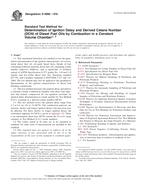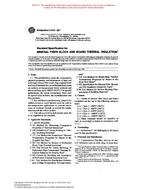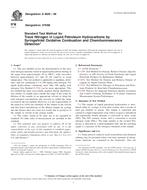1.1 This test method covers an engine test procedure for evaluating automotive engine oils for certain high-temperature performance characteristics, including oil thickening, varnish deposition, oil consumption, as well as engine wear. Such oils include both single viscosity grade and multiviscosity grade oils that are used in both spark-ignition, gasoline-fueled engines, as well as in diesel engines.
1.1.1 Additionally, with nonmandatory supplemental requirements, a IIIGA Test (Mini Rotary Viscometer and Cold Cranking Simulator measurements), a IIIGVS Test (EOT viscosity increase measurement), or a IIIGB Test (phosphorous retention measurement) can be conducted. These supplemental test procedures are contained in Appendixes Appendix X1, Appendix X2, and Appendix X3, respectively.
Note 1 – Companion test methods used to evaluate engine oil performance for specification requirements are discussed in SAE J304.
1.2 The values stated in SI units are to be regarded as standard. No other units of measurement are included in this standard.
1.2.1 Exception – Where there is no direct SI equivalent such as screw threads, national pipe threads/diameters, and tubing size.
1.3 This standard does not purport to address all of the safety concerns, if any, associated with its use. It is the responsibility of the user of this standard to establish appropriate safety and health practices and determine the applicability of regulatory limitations prior to use. Specific warning statements are provided in 6.14.1.1 and 7.1.
1.4 This test method is arranged as follows:
| Section | |
|---|---|
| Introduction | |
| Scope | 1 |
| Referenced Documents | 2 |
| Terminology | 3 |
| Summary of Test Method | 4 |
| Significance and Use | 5 |
| Apparatus | 6 |
| Laboratory | 6.1 |
| Drawings | 6.2 |
| Specified Equipment | 6.3 |
| Test Engine | 6.4 |
| Engine Parts | 6.4.1 |
| Engine Speed and Load Control | 6.5 |
| Fluid Conditioning Module | 6.6 |
| Engine Cooling System | 6.6.1 |
| Flushing Tank | 6.7 |
| Coolant Mixing Tank | 6.8 |
| Condenser Cooling Systems | 6.9 |
| Engine Oil-Cooling System | 6.10 |
| Fuel System | 6.11 |
| Induction Air Supply Humidity, Temperature, and Pressure | 6.12 |
| Temperature Measurement | 6.13 |
| Thermocouple Location | 6.13.1 |
| Air-to-Fuel Ratio Determination | 6.14 |
| Injector Flow Testing | 6.14.1 |
| Exhaust and Exhaust Back Pressure Systems | 6.15 |
| Blowby Flow Rate Measurement | 6.16 |
| Pressure Measurement and Sensor Location | 6.17 |
| Reagents and Materials | 7 |
| Test Fuel | 7.1 |
| Engine and Condenser Coolant | 7.2 |
| Coolant Additive | 7.3 |
| Coolant Preparation | 7.4 |
| Pre-Test Cleaning Materials | 7.5 |
| Sealing and Anti-seize Compounds | 7.6 |
| Test Oil Sample Requirements | 8 |
| Preparation of Apparatus | 9 |
| Condenser Cleaning | 9.1 |
| Intake Manifold Cleaning | 9.2 |
| Cleaning of Engine Parts (other than the block and heads) | 9.3 |
| Connecting Rod Cleaning | 9.4 |
| Engine Block Cleaning | 9.5 |
| Cylinder Head Cleaning | 9.6 |
| Engine Build-up Procedure | 9.7 |
| General Information | 9.7.1 |
| Special Parts | 9.7.2 |
| Hardware Information | 9.7.3 |
| Fastener Torque Specifications and Torquing Procedures | 9.7.4 |
| Main Bearing Cap Bolts | 9.7.4.1 |
| Cylinder Head Bolts | 9.7.4.2 |
| Torques for Miscellaneous Bolts, Studs, and Nuts | 9.7.4.3 |
| Parts Replacement | 9.8 |
| Engine Block Preparation | 9.9 |
| Piston Fitting and Numbering | 9.10 |
| Piston Ring Fitting | 9.10.1 |
| Pre-Test Camshaft and Lifter Measurements | 9.11 |
| Camshaft Bearing Installation | 9.12 |
| Camshaft Installation | 9.13 |
| Main Bearings | 9.14 |
| Crankshaft Installation | 9.14.1 |
| Main Bearing Cap Installation | 9.14.2 |
| Crankshaft Sprocket | 9.15 |
| Camshaft Sprocket and Timing Chain | 9.16 |
| Crankshaft End Play | 9.17 |
| Piston Pin Installation | 9.18 |
| Piston Installation | 9.18.1 |
| Harmonic Balancer | 9.19 |
| Connecting Rod Bearings | 9.20 |
| Engine Front Cover | 9.21 |
| Coolant Inlet Adapter | 9.22 |
| Oil Dipstick Hole | 9.23 |
| Oil Pan | 9.24 |
| Cylinder Head Assembly | 9.25 |
| Adjustment of Valve Spring Loads | 9.26 |
| Cylinder Head Installation | 9.27 |
| Hydraulic Valve Lifters | 9.28 |
| Pushrods | 9.29 |
| Valve Train Loading | 9.30 |
| Intake Manifold | 9.31 |
| Rocker Covers | 9.32 |
| Water Inlet Adapter | 9.33 |
| Condenser | 9.34 |
| Coolant Outlet Adapter | 9.35 |
| Oil Filter Adapter | 9.36 |
| Oil Sample Valve | 9.37 |
| Ignition System | 9.38 |
| Throttle Body | 9.39 |
| Accessory Drive Units | 9.40 |
| Exhaust Manifolds, Water-Cooled | 9.41 |
| Engine Flywheel | 9.42 |
| Pressure Checking of Engine Coolant System | 9.43 |
| Lifting of Assembled Engines | 9.44 |
| Mounting the Engine on the Test Stand | 9.45 |
| External Cooling System Cleaning | 9.46 |
| Engine Coolant Jacket Cleaning (Flushing) | 9.47 |
| Coolant Charging | 9.48 |
| Test Oil Charging | 9.49 |
| Engine Oil Pump Priming | 9.50 |
| Calibration | 10 |
| Laboratory and Engine Test Stand Calibration | 10.1 |
| Testing of Reference Oils | 10.2 |
| Reference Oil Test Frequency | 10.3 |
| Reporting of Reference Oil Test Results | 10.4 |
| Evaluation of Reference Oil Test Results | 10.5 |
| Status of Non-Reference Oil Tests Relative to Reference Oil Test |
10.6 |
| Status of Test Stands Used for Non-Standard Tests | 10.7 |
| Data Acquisition and Control | 10.8 |
| Sample Rate | 10.8.1 |
| Measurement Accuracy | 10.8.2 |
| Temperature | 10.8.3 |
| Pressure | 10.8.4 |
| Flow | 10.8.5 |
| Speed | 10.8.6 |
| Load | 10.8.7 |
| Measurement Resolution | 10.8.8 |
| System Time Response | 10.8.9 |
| Quality Index | 10.8.10 |
| Engine Operating Procedure | 11 |
| Dipstick and Hole Plug | 11.1 |
| Dipstick Hole O-ring | 11.2 |
| Engine Start-up and Shutdown Procedures | 11.3 |
| Start-up | 11.4 |
| Scheduled Shutdown | 11.5 |
| Non-Scheduled Shutdowns | 11.6 |
| Oil Sampling | 11.7 |
| Oil Leveling | 11.8 |
| Air-to-Fuel-Ratio Measurement and Control | 11.9 |
| Air-to-Fuel Ratio Verification | 11.10 |
| Blowby Flow Rate Measurement | 11.11 |
| NOx Determinations | 11.12 |
| Data Recording | 11.13 |
| Initial run (10 min) | 11.14 |
| Engine Oil Quality Testing (100 h) | 11.15 |
| Test Termination | 11.16 |
| Determination of Test Results | 12 |
| Engine Disassembly | 12.2 |
| Preparation of Parts for Rating of Sticking, Deposits, and Plugging |
12.3 |
| Piston Deposit Rating | 12.4 |
| Post-Test Camshaft and Lifter Wear Measurements | 12.5 |
| Viscosity Test | 12.6 |
| Testing Oil Samples for Wear Metals | 12.7 |
| Blowby Flow Rate Measurements | 12.8 |
| Oil Consumption Computation | 12.9 |
| Photographs of Test Parts | 12.10 |
| Retention of Representative Test Parts | 12.11 |
| Severity Adjustments | 12.12 |
| Determination of Operational Validity | 12.13 |
| Report | 14 |
| Report Forms | 14.1 |
| Precision of Reported Units | 14.2 |
| Precision and Bias | 15 |
| Keywords | 16 |
| The Role of the ASTM Test Monitoring Center (TMC) and the Calibration Program |
Annex A1 |
| Sequence IIIG Test Parts Replacement Guidelines | Annex A2 |
| Sequence IIIG Determination Volume of Engine Oilin Pan | Annex A3 |
| Sequence IIIG Test Fuel Analysis | Annex A4 |
| Sequence IIIG Test Reporting | Annex A5 |
| Sequence IIIG Test Air-to-Fuel Ratio Control Flow Chart | Annex A6 |
| Sequence IIIG Test Set Points and Control States | Annex A7 |
| Sequence IIIG Quality Index Upper and Lower Values | Annex A8 |
| Sequence IIIG Engine Oil Level Worksheet | Annex A9 |
| Blowby Flow Rate Determination | Annex A10 |
| Safety Hazards | Annex A11 |
| Sequence IIIG Blueprint Listing | Annex A12 |
| Fluid Condition Module components | Annex A13 |
| Engine Build Worksheets | Annex A14 |
| Engine Oil Cooling System Schematic | Annex A15 |
| Sequence IIIGA Test Procedure | Appendix X1 |
| Sequence IIIGVIS Test Procedure | Appendix X2 |
| Sequence IIIGB Test Procedure | Appendix X3 |
Product Details
- Published:
- 04/15/2012
- Number of Pages:
- 49
- File Size:
- 1 file , 770 KB
- Redline File Size:
- 2 files , 1.4 MB


